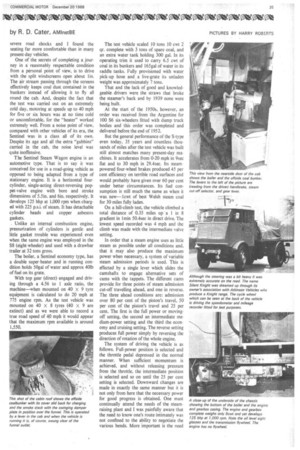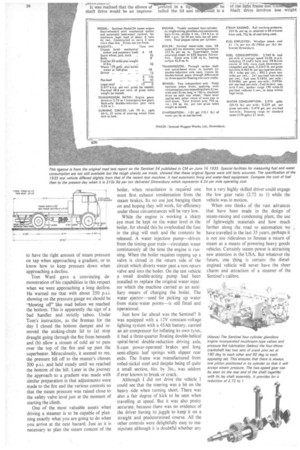Commercial Motor Christmas Road Test
Page 36

Page 37

Page 38

If you've noticed an error in this article please click here to report it so we can fix it.
ENTINEL 4T TEAMER
by R. D. Cater, AMInstBE
THROUGHOUT the first two decades of mechanized road haulage, the steam lorry played a large and continuous role. But by the early 1930s penalizing legislation and the introduction of reliable diesel engines had practically forced steamer builders to give up.
The Shrewsbury-based firm of Sentinel, however, went ahead well into the 30s with steam lorry development and production. In its final form the S-Type steamer was years ahead of its tithe in many respects.
During the present age of transport one often hears the plea for a constant-horsepower engine. This was of course just what the steamer had. Its power output stems from its boiler and it has full power from a standing start. Because its engine is direct reversing and will pull from stationary, it needs no clutch or sophisticated transmission.
Recently I was able to carry out a limited road test of a 1933 Sentinel S 41, a fourwheeler designed for drawbar trailer operation. In operating trim it would handle a 14-ton payload 7 tons on the vehicle and 7 tons on the trailer.
The test vehicle has been completely renovated by Mr. Tom Ward of Transport Vehicles (Warrington) Ltd. fame. Mr Ward is one of the most knowledgeable steamer men alive today—and there is no doubt that to get the best out of this fascinating goods-carrying vehicle, one needs to be well-informed. The machine had been in service with the old Gas Light and Coke Co. Ltd. (now North Thames Gas), first as a coke delivery unit and latterly as a tar sprayer. Mr. Ward spent four years renovating the vehicle and now drives it at various rallies and on sundry jaunts around his North Wales home.
One of the first things that newcomers to steamer-handling must learn is to spit first before touching anything in the cab, for most things around the boiler are pretty hot as I found out to my cost. However, the degree of riding comfort is quite surprising when one considers the vehicle's age. Long fine-cambered leaf springs at the front axle iron out all but the most severe road shocks and I found the seating far more comfortable than in many present-day vehicles.
One of the secrets of completing a journey in a reasonably respectable condition from a personal point of view, is to drive with the split windscreens open about lin. The air stream passing through the screens effectively keeps coal dust contained in the bunkers instead of allowing it to fly all round the cab. And, despite the fact that the test was carried out on an extremely cold day, motoring at speeds up to 40 mph for five or six hours was at no time cold or uncomfortable, for the "heater" worked extremely well. From a noise point of view, compared with other vehicles of its era, the Sentinel was in a class all of its own. Despite its age and all the extra "gubbins" carried in the cab, the noise level was quite inoffensive.
The Sentinel Steam Wagon engine is an automotive type. That is to say it was conceived for use in a road-going vehicle as opposed to being adapted from a type of stationary engine. It is a horizontal fourcylinder, single-acting direct-reversing poppet-valve engine with bore and stroke dimensions of 5.5in. and 6in. respectively. It develops 125 bhp at 1,000 rpm when charged with 225 p.s.i. of steam. It has detachable cylinder heads and copper asbestos gaskets.
. Unlike an internal combustion engine, pressurization of cylinders is gentle and little gasket trouble was experienced even when the same engine was employed in the S8 (eight-wheeler) and used with a drawbar trailer at 32 tons gross.
The boiler, a Sentinel economy type, has a double super-heater and in running condition holds 50gal of water and approx 401b of fuel on its grate.
With top gear (direct) engaged and driving through a 4.56 to I. axle ratio, the machine—when mounted on 40 X 9 tyre equipment is calculated to do 20 mph at 775 engine rpm. As the test vehicle was mounted on 40 X 8 tyres (40 x 9 are extinct) and as we were able to record a true road speed of 49 mph it would appear that the maximum rpm available is around 1,550. The test vehicle scaled 10 tons 10 cwt qr. complete with 3 tons of spare coal, and an extra water tank holding 300 gal. In its operating trim it used to carry 6.5 cwt of coal in its bunkers and 165ga1 of water in its saddle tanks. Fully provisioned with water pick-up hose and a live-grate its unladen weight was approximately 7 tons.
That and the lack of good and knowledgeable drivers were the straws that broke the steamer's back and by 1939 none were being built.
At the start of the 1950s, however, an order was received from the Argentine for 100 S6 six-wheelers fitted with dump truck bodies and this order was completed and delivered before the end of 1952.
But the general performance of the S-type even today, 35 years and countless thousands of miles after the test vehicle was built still almost matches many present-day machines. It accelerates from 0-20 mph in 9sec flat and to 30 mph in 29.4sec. Its steampowered four-wheel brakes produced 45 per cent efficiency on terrible road surfaces and would probably have given over 60 per cent under better circumstances. Its fuel consumption is still much the same as when it was new—lcwt of best Welsh steam coal for 30 miles fully laden.
On a hill-climb test, the vehicle climbed a total distance of 0.35 miles up ' a 1 in 8 gradient in lmin 50.4sec in direct drive. The lowest speed recorded was 4 mph and the climb was made with the intermediate valve setting.
In order that a steam engine uses as little steam as possible under all conditions and, that it may also produce the maximum power when necessary, a system of variable steam admission periods is used. This is effected by a single lever which slides the camshafts to engage alternative 'sets of cams with the tappets. The different cams provide for three points of steam admission cut-off travelling ahead, and one in reverse. The three ahead conditions are: admission over 80 per cent of the piston's travel, 50 per cent of the piston's travel and 25 per cent. The first is the full power or movingoff setting, the second an intermediate medium-power setting and the third the economy and cruising setting. The reverse setting produces full power simply by reversing the direction of rotation of the whole engine.
The system of driving the vehicle is as follows. Full-power position is selected and the throttle pedal depressed in the normal manner. When sufficient momentum is achieved, and without releasing pressure from the throttle, the intermediate position is selected and so on until the 25 per cent setting is selected. Downward changes are made in exactly the same manner but it is not only from here that the necessary power for good progress is obtained. One must continually attend the needs of the steamraising plant and I was painfully aware that the need to know one's route intimately was not confined to the ability to negotiate the various bends. More 'important is the need to have the right amount of steam pressure on tap when approaching a gradient, or to know how to keep pressure down when approaching a decline.
Tom Ward gave a convincing demonstration of his capabilities in this respect when we were approaching a long decline. He warned me that with about 250 p.s.i. showing on the pressure gauge we should be "blowing off" like mad before we reached the bottom. This is apparently the sign of a bad handler and strictly taboo. Under Tom's instruction, as the fireman for the day I closed the bottom damper and removed the stoking-chute lid to (a) stop draught going through the fire from beneath and (b) allow a stream of cold air to pass over the top of the fire and up past the superheater. Miraculously, it seemed to me, the pressure fell off to the master's chosen 200 p.s.i. and held steady until we reached the bottom of the hill. Later in the journey the approach to a gradient was made with similar preparation in that adjustments were made to the fire and the various controls so that the steam pressure was raised close to the safety valve level just at the moment of starting the climb.
One of the most valuable assets when driving a steamer is to be capable of planning exactly what you are going to do when you arrive at the next hazard. Just as it is necessary to plan the steam content of the boiler, when retardation is required one must first exhaust condensation from the steam brakes. Its no use just banging them on and hoping they will work, for efficiency under those circumstances will be very low.
While the engine is working a sharp eye must be kept on the water level in the boiler, for should this be overlooked the fuse in the plug will melt and the contents be released. A water injection pump driven from the timing-gear train—circulates water continuously all the time the engine is running. When the boiler requires topping up a valve is closed in the return side of the circuit which diverts water past a non-return valve and into the boiler. On the test vehicle a small double-acting pump had been installed to replace the original water injector which the machine carried as an auxiliary means of charging the boiler. The water ejector—used for picking up water from static-water points—is still fitted and operational.
Just how far ahead was the Sentinel? It was equipped with a 12V constant-voltage lighting system with a 45Ah battery, carried an air-compressor for inflating its own tyres, it had a three-quarter floating double-helical spiral-bevel double-reduction driving axle, S-cam power-operated brakes and long semi-elliptic leaf springs with slipper rear ends. The frame was manufactured from rolled-nickel steel and despite being of quite a small section, 6in. by 3in., was seldom if ever known to break or crack.
Although I did not drive the vehicle I could see that the steering was a bit on the heavy side when turning short. There was also a fair degree of kick to be seen when travelling at speed. But it was also pretty accurate, because there was no evidence of the driver having to juggle to keep it on a straight and predetermined course. All the other controls were delightfully easy to manipulate although it is doubtful whether an
but a very highly skilled driver could engage the low gear ratio (2.72 to 1) while the vehicle was in motion.
When one thinks of the vast advances that have been made in the design of steam-raising and condensing plant, the use of lightweight materials and how much farther along the road to automation we have travelled in the last 35 years, perhaps it is not too ridiculous to foresee a return of steam as a means of powering heavy goods vehicles. Certainly steam power is attracting new attention in the USA. But whatever the future, one thing is certain: the dieselengined vehicle will never have the sheer charm and attraction of a steamer of the Sentinel's calibre.


























































































